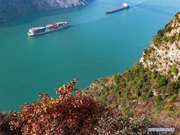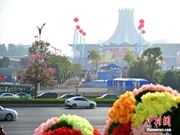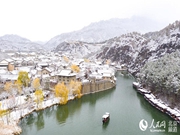

A website that shares water resources information among six countries along the Lancang-Mekong River was launched Monday in Beijing, aiming to enhance the sharing of hydrological data, information, knowledge, experience and technologies.
The Lancang River, which rises on the Qinghai-Tibet Plateau in China, is called Mekong after flowing out of the country into Myanmar, Laos, Thailand, Cambodia, Vietnam. It finally runs into the South China Sea.
Sharing the same river, the Lancang-Mekong countries are indeed a community with a shared future. Therefore, water resource cooperation is always a priority of the Lancang-Mekong cooperation mechanism.
This year, the Lancang-Mekong countries officially kicked off 20 pragmatic cooperation programs in coping with climate change, dam security, drinking water safety, and flood and drought control. From Nov. 1, China has formally started providing the Mekong River Commission Secretariat with year-round hydrological data of the Lancang River. Besides, the 95 proposals raised at the first Ministerial Meeting of Lancang-Mekong Water Resources Cooperation held last year are also under implementation.
By carrying out cooperation on hydrological infrastructure construction, sharing water resource information, and establishing relevant professional organizations in the spirit of unity and mutual assistance, China and Mekong countries have improved their capability to allocate and manage the water resources in the Lancang-Mekong River and injected vitality into regional development and livelihood for the people along the river.
"The water level in the Mekong River and its tributaries rises every time the rainy season comes, which might lead to floods, debris flows and other natural disasters," said the director of the Lao national water information center. He told People's Daily that in the past, the water level had to be measured by staffs in the rain, while today the electronic devices in hydrological stations are able to finish the task, thanks to the water information center aided by China.
The center is a demonstration aid project of the Chinese government, as well as one of the early fruits reaped by the Lancang-Mekong cooperation. It has helped Laos preliminarily acquire the ability to collect, transmit, and process hydrological data, and to make hydrological warnings.
China has always reiterated to fully respect the legitimate rights and interests of each country to properly develop and exploit water resources, and take care of each other's interests and concerns.
At the end of 2015, the Lancang-Mekong countries suffered droughts due to a strong El Nino, which reduced the water level of the Mekong River to the lowest in 90 years. To take care of the concerns of the Mekong countries, the Chinese government decided to discharge water from a hydropower station in Jinghong, Yunnan province to downstream Mekong River for emergency use in March 2016, despite of its own difficulties.
The emergency discharge benefited Laos, Myanmar, Thailand, Cambodia and Vietnam. Three days after the outflow increase, the water level of the Mekong River in north Thailand's Chiang Saen went up to 3.29 meters from around 2.3 to 2.5 meters.
Close neighbors are better than distant relatives, said Sommad Pholsena, Lao Minister of Natural Resources and Environment during an interview with People's Daily. He called China a responsible cooperation partner, saying they would never forget China's assistance to Mekong countries.
The study of water resources have always been a focus of the Lancang-Mekong cooperation. A joint work team has been established among the Lancang-Mekong countries, and the Ministerial Meeting of Lancang-Mekong Water Resources Cooperation has also been developed into a regular event. Besides, the Lancang-Mekong countries have implemented a five-year action plan on water resources cooperation and launched cooperation projects of dam security and flood warning, so as to improve comprehensive management of the river and the capability to manage water resources, and lift their water resources cooperation onto new levels.
The six countries has jointly established a water resources cooperation center, an environmental cooperation center and the Global Center for Mekong River Studies to share hydrological information. China's sharing of year-round hydrological data of the Lancang River this year is another public product provided by the country to deepen Lancang-Mekong water resources cooperation, as well as a new contribution to improving the region's capability to cope with climate change and natural disasters.
The Lancang-Mekong cooperation has become one of the most energetic and fruitful cooperation mechanisms of the region, said Surasit Thanadtang, senior researcher with the National Research Council of Thailand. He believes the cooperation will forge a concerted power and inject more vitality into sub-regional and regional development and prosperity.

 Winter scenery of Three Gorges in Hubei
Winter scenery of Three Gorges in Hubei In pics: WTT Macao 2020 Tournament semifinals
In pics: WTT Macao 2020 Tournament semifinals Snow scenery of Huoshan Mountain in east China
Snow scenery of Huoshan Mountain in east China 17th China-ASEAN Expo to be held in Nanning
17th China-ASEAN Expo to be held in Nanning In pics: silver pheasants in front of waterfall
In pics: silver pheasants in front of waterfall Beijing's Gubei Water Town ushers in first snowfall of winter
Beijing's Gubei Water Town ushers in first snowfall of winter Silk figurines revitalize in Beijing
Silk figurines revitalize in Beijing Christmas lights shine in central London, Britain
Christmas lights shine in central London, Britain Tourists view ginkgo trees in Hunan
Tourists view ginkgo trees in Hunan CIIE showcases cultural items from around the world
CIIE showcases cultural items from around the world